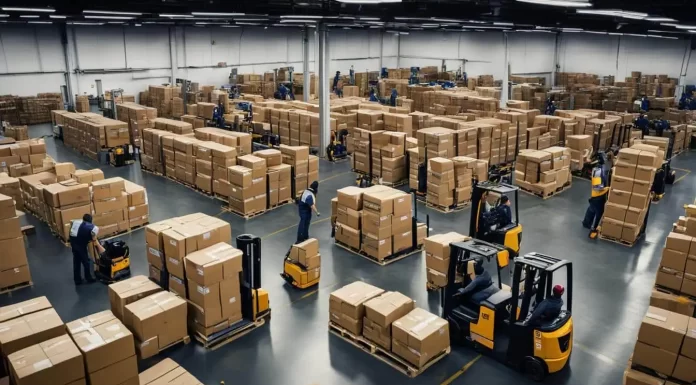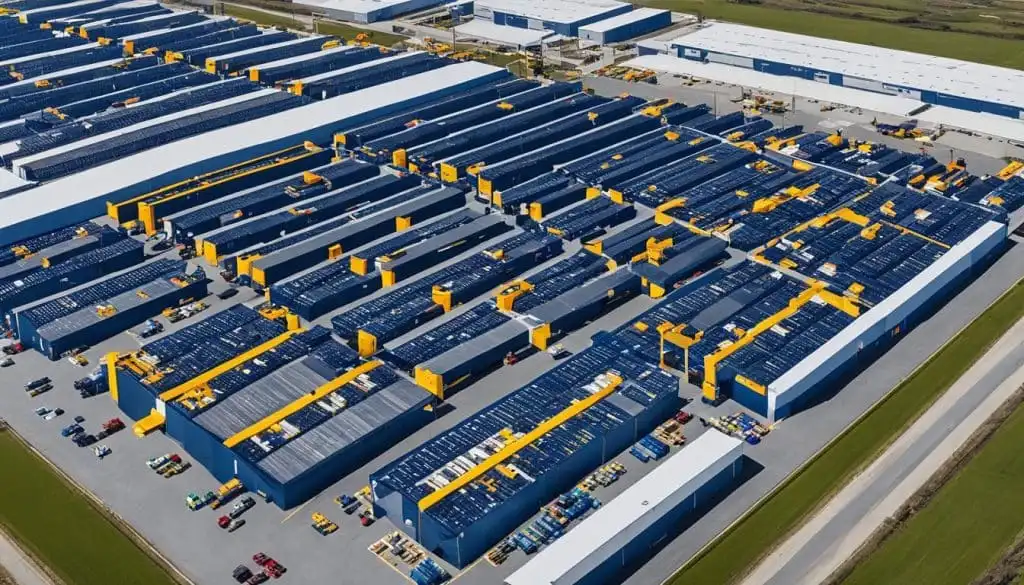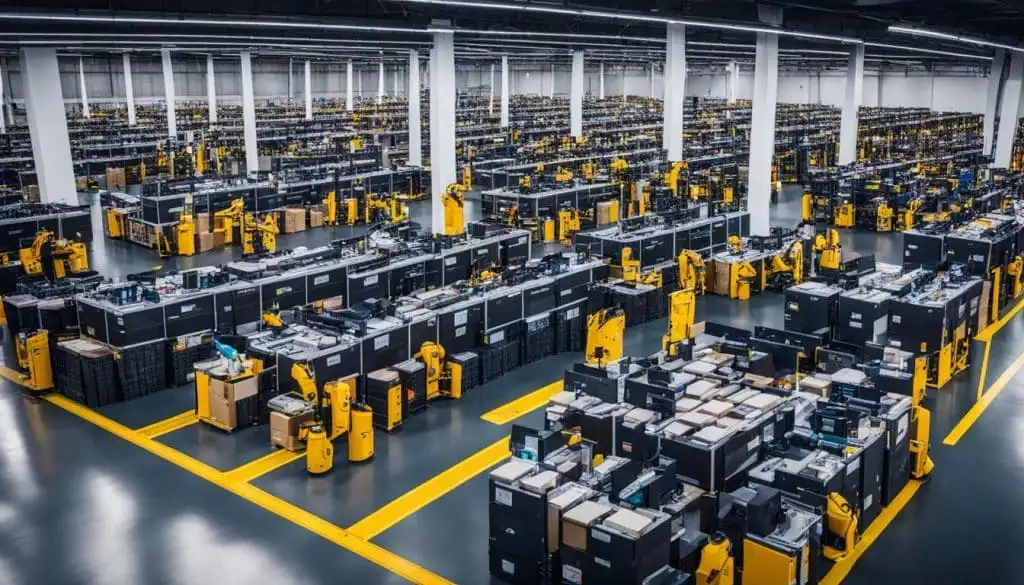Welcome to our article series where we dive into the world of retail warehouse optimization specifically tailored for businesses in the Philippines. Efficient warehouse management is a crucial aspect of running a successful retail business, providing cost savings and enhancing customer satisfaction. In this section, we will explore the importance of warehouse management and its benefits for the Philippines business industry.
When it comes to retail warehousing, optimizing operations is essential for businesses in the Philippines. By implementing efficient warehouse management strategies, you can streamline processes, reduce costs, and ensure smooth operations. In this article, we will guide you through the key aspects of warehouse optimization specifically curated for the Philippines business landscape.
From understanding the retail warehousing landscape in the Philippines to exploring different warehouse models and discussing key strategies, we will provide you with valuable insights and actionable tips to improve your retail warehouse operations. We will also delve into the integration of technology, address challenges faced in the industry, and explore sustainability practices that are becoming increasingly important.
By the end of this article series, you will have a comprehensive understanding of how to optimize your retail warehouse operations for maximum efficiency and success in the Philippines business environment. So let’s dive in and discover the world of retail warehouse optimization together!
Understanding the Retail Warehousing Landscape in the Philippines
In this section, we will provide you with an overview of the retail warehousing landscape in the Philippines. Understanding the current trends and developments in retail warehousing is crucial for businesses operating in the Philippines to stay competitive in this dynamic market.
The retail warehousing landscape in the Philippines has experienced significant changes in recent years, driven by economic growth and advancements in technology. These factors have revolutionized the way retailers handle their supply chain operations.
One of the prominent trends in the retail warehousing sector is the adoption of technology and automation. With the advancement of technology, businesses are leveraging innovative solutions to streamline their warehouse operations. Automation tools such as robotics, AI-powered inventory management systems, and real-time tracking systems have become integral parts of efficient retail warehousing in the Philippines.
Economic growth in the Philippines has also played a vital role in shaping the retail warehousing landscape. The country’s booming economy has resulted in increased consumer demand and a thriving retail industry. As a result, businesses have been prompted to optimize their warehousing operations to meet the growing needs of the market.
Furthermore, the retail warehousing landscape in the Philippines is influenced by the unique characteristics of its market. The country’s archipelagic geography poses logistical challenges, requiring businesses to develop innovative strategies to ensure efficient distribution and timely delivery of goods across different regions.
To stay competitive in the evolving retail landscape of the Philippines, businesses need to stay updated with the latest trends and advancements in retail warehousing. By leveraging technology, optimizing operations, and adapting to the changing market demands, businesses can maximize efficiency, reduce costs, and deliver exceptional customer experiences.
Types and Benefits of Different Retail Warehouse Models
In the Philippines, businesses have a variety of retail warehouse models to choose from. Each model offers unique advantages and benefits, allowing businesses to tailor their warehouse operations to suit their specific needs and requirements. Understanding the different types of retail warehouse models can help businesses make informed decisions and optimize their operations effectively.
Centralized Warehouses
Centralized warehouses are large-scale facilities located in a central location, typically near major transportation hubs. These warehouses act as distribution centers, serving multiple retail locations across the Philippines. The main benefit of centralized warehouses is the consolidation and centralized management of inventory, resulting in cost savings through economies of scale.
Decentralized Warehouses
Decentralized warehouses, on the other hand, are smaller-scale facilities strategically positioned in various regions or localities. These warehouses are closer to the retail locations they serve, reducing transportation costs and delivery times. Decentralized warehouses enable businesses to respond rapidly to local market demands, ensure product availability, and provide efficient customer service.
Public Warehouses
Public warehouses offer shared storage and distribution services to multiple businesses. These facilities provide flexibility, as businesses can rent specific storage space according to their needs and change space requirements as their business fluctuates. Public warehouses often come equipped with advanced technology and infrastructure, reducing upfront investment costs for businesses.
Private Warehouses
Private warehouses are owned and operated by individual businesses. These warehouses provide complete control and customization over the storage and distribution processes. Private warehouses are particularly beneficial for businesses with high storage demands, specialized requirements, or the need for strict quality control. However, they require significant upfront capital investment and ongoing maintenance costs.
By carefully considering the advantages and benefits of each retail warehouse model, businesses can optimize their operations, reduce costs, improve supply chain efficiency, and ensure customer satisfaction in the dynamic retail landscape of the Philippines.

Key Strategies for Retail Warehouse Optimization
To maximize efficiency and drive success in your retail warehouse operations in the Philippines, it is crucial to implement key strategies for warehouse optimization. By adopting lean warehousing practices, businesses can eliminate waste, streamline processes, and enhance overall performance.
Lean warehousing practices focus on the continuous improvement of operations, making them an ideal approach for optimizing your retail warehouse. Here are some key strategies to consider:
- Effective Inventory Management: Accurate inventory management is essential for efficient warehouse operations. Implementing inventory control systems, conducting regular audits, and utilizing real-time tracking can help you optimize your inventory levels and minimize stockouts.
- Optimized Layout and Storage: Analyze and optimize your warehouse layout to ensure that it promotes efficient movement of goods and minimizes unnecessary travel distances. Utilize vertical space and consider implementing automated storage and retrieval systems to maximize storage capacity.
- Streamlined Order Fulfillment Processes: Implement streamlined order picking and packing processes to minimize errors and reduce order processing times. Utilize technology such as barcode scanning and mobile devices to facilitate accurate and efficient order fulfillment.
- Data-Driven Decision Making: Leverage data analytics to gain insights into your warehouse operations and identify areas for improvement. Analyzing key performance indicators (KPIs) such as order cycle time, order accuracy, and inventory turnover can help you make data-driven decisions to optimize your warehouse processes.
- Continuous Improvement and Training: Foster a culture of continuous improvement within your warehouse by encouraging feedback from employees and providing training opportunities. Empower your staff to identify and implement process improvements, and regularly evaluate and update your standard operating procedures.
By implementing these key strategies, you can significantly enhance the efficiency and productivity of your retail warehouse operations in the Philippines. With optimized warehouse processes, you can improve customer satisfaction, reduce costs, and gain a competitive edge in the market.
Technology Integration in Retail Warehousing
Technology plays a vital role in modern retail warehousing operations, offering numerous benefits and opportunities for businesses in the Philippines. By leveraging automation and data analytics, retailers can streamline their warehouse processes, enhance efficiency, and improve overall productivity.
One of the key advantages of technology integration with a retail management system is automation. Implementing automated systems and machinery within the retail management system can help optimize repetitive tasks, such as inventory tracking, order fulfillment, and replenishment. This not only reduces the reliance on manual labor but also minimizes the risk of errors, leading to improved accuracy and faster turnaround times.
Furthermore, data analytics plays a crucial role in retail warehousing. By analyzing vast amounts of data collected from various sources, businesses can gain valuable insights into their inventory management and supply chain processes. This allows for better forecasting, improved demand planning, and more efficient allocation of resources. With the help of data analytics tools, retailers in the Philippines can identify patterns, trends, and potential bottlenecks, enabling them to make data-driven decisions and optimize their operations.
Integrating technology such as retail software into warehousing brings transformative benefits that ultimately drive business growth. It enables retailers to meet customer demands more effectively, improve order accuracy, reduce costs, and enhance overall operational efficiency. Embracing technology integration in retail warehousing is the key to staying competitive in the dynamic retail landscape of the Philippines.

Challenges in Retail Warehousing and Solutions
Retail warehousing in the Philippines faces several challenges that can impact the efficiency and effectiveness of operations. This section will address two key challenges: space constraints and logistics, as well as navigating the complexities of multi-channel retailing.
Space Constraints and Optimization Solutions
Limited space is a common challenge in retail warehousing. With the growing demands of e-commerce and omni-channel retailing, businesses need to maximize space utilization while ensuring smooth operations.
One solution to optimize space utilization is implementing efficient storage systems, such as vertical racking and automated picking solutions. These systems help maximize vertical space and increase storage capacity.
Utilizing advanced inventory management and Warehouse operations system tools can also aid in space optimization. These warehouse management systems enable businesses to accurately track inventory levels, streamline picking processes, and allocate storage space more effectively.
Navigating Multi-Channel Retailing Challenges
In the era of multi-channel retailing, businesses face the challenge of coordinating and fulfilling orders across different sales channels, including online platforms, brick-and-mortar stores, and third-party marketplaces.
One solution to overcome this challenge is implementing an integrated inventory management system that connects with all sales channels. This centralized system allows businesses to accurately track inventory levels, avoid stockouts, and ensure a seamless shopping experience for customers.
In addition, adopting a flexible and efficient order fulfillment strategy is crucial for multi-channel retailing success. By utilizing a combination of in-house fulfillment centers, drop shipping and third-party logistics providers, businesses can optimize order fulfillment processes and meet customer expectations effectively.
By addressing space constraints, optimizing logistics, and strategizing for multi-channel retailing, businesses in the Philippines can overcome challenges in retail warehousing and enhance their overall operational efficiency.
Sustainability Practices in Retail Warehousing
With sustainability becoming increasingly important, implementing eco-friendly practices in retail warehousing is crucial for businesses in the Philippines. Embracing sustainability not only aligns with global environmental goals but also brings long-term benefits to your operations. By adopting sustainable practices in your retail warehouse, you can contribute to waste reduction, and energy efficiency, and create a greener future.
One key aspect of sustainable warehousing is the adoption of eco-friendly storage solutions. This involves using environmentally friendly materials for packaging and storage, such as biodegradable or recyclable materials. Implementing eco-friendly storage solutions not only reduces the ecological footprint of your warehouse but also showcases your commitment to sustainable business practices.
An effective waste reduction strategy should also be a priority in your retail warehouse operations. Consistently analyzing and optimizing your inventory management can minimize waste and prevent overstocking or underutilization of goods. Additionally, implementing recycling programs and educating your staff on proper waste disposal practices can further reduce your environmental impact.
Energy efficiency is another essential component of sustainable retail warehousing. Introduce energy-saving measures, such as using energy-efficient lighting, optimizing temperature control systems, and investing in renewable energy sources where feasible. By reducing energy consumption, you can not only decrease your operational costs but also contribute to the fight against climate change.






















